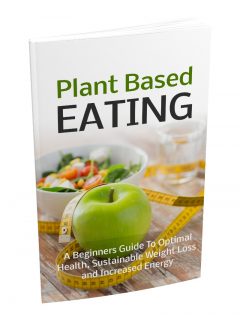 License Type: Master Resell Rights
License Type: Master Resell Rights  File Type: ZIP
File Type: ZIP
 SKU: 63098
SKU: 63098  Shipping: Online Download
Shipping: Online Download
Sample Content Preview
Introduction
As our society evolves, we are constantly facing the need to change our behaviors and habits to increase our health and quality of life. We are now facing climate change, food insecurity and over 40% of our population is suffering from chronic disease.
One of the recent ideas put forward to improve our world and health is the plant-based nutrition.
Even though food regiments are not something our doctor prescribes (yet), research is showing that food has a lot to contribute to our health. It is also a less costly option to our society than prescribing medication.
Whether you want to save the animals, become healthier or simply feel better, the plant-based nutrition is a great option for those of us who want to be a better and healthier person.
Choosing a plant-based nutrition doesn’t have to be a complex commitment. With the help of this guide, you will be ready to step into the world of plant-based eating in no time and set yourself up for success.
In this book, you will learn about plant-based nutrition, the research about it and how you can successfully transition into a plant-based nutrition. You will also find some recipes to kick-start your journey and find answers to questions that might be limiting you in your transition to a plant-based nutrition.
First, let’s define what plant-based eating is all about.
Chapter 1: What is plant-based eating?
We are hearing the word plant-based nutrition more and more in our society. With the launch of documentaries like Game Changers, books like Forks over knives and the emergence of athletes changing their nutrition to be plant-based, one has to wonder what this is all about.
Our understanding of plant-based eating may differ from one individual to another. In the world of nutrition, plant-based eating is having a large portion of one’s nutrition coming from vegetables, fruits, herbs, nuts, whole grains and also include legumes or other plants.
A spectrum of plant-based nutrition options is available to you. Some are very strict (vegan diet), others are still adding animal products like dairy (vegetarian) and at the other end of the spectrum are those that still eat meat, poultry and fish on an occasional basis.
We once believed that early humans consumed a large proportion of animal protein in their diet. It is from that belief that, in the 2000s, the Paleo diet (mainly comprised of animal protein) became really popular in the world of nutrition and diet.
Although, we now know that the nutrition of bipedal primates and Homo sapiens was primarily composed of nuts, fruits, leaves, roots, seeds and water. In that case, the “original” Paleo Diet was in reality plant-based eating. It is also linked to the fact that some of the strongest animals on Earth are not carnivores. The strongest mammal is the gorilla (most are herbivores). It has the ability to lift around 4409 lbs., that is 10 times its body weight. It would be like a 200 lb. individual lifting 2000 lb. If other mammals can live a healthy and strong life on a plant-based nutrition, we probably can too.
Why choose a plant-based nutrition?
Many reasons exist for choosing a plant-based nutrition, we will discuss in more details some of those reasons but here’s our top 5:
1) Improve your health: Most Americans consume double the recommended daily intake of protein which can also cause issues with digestion. By reducing your intake of animal food, you will most likely reach the recommended daily intake of protein without surpassing it. In addition, an increased consumption of vegetables, grains and beans will bring more fiber into your nutrition. Most Americans don’t consume enough fiber and that can lead to inflammation of the digestive tract, constipation and hemorrhoids.
2) Succeed in weight loss and weight management: In general, individuals who are on a plant-based nutrition tend to consume fewer calories than individuals who consume animal protein. That is because most of their calories are coming from healthier options and fewer calories per weight. Plant-based eaters tend to eat less process food and avoid meat focused restaurants like fast-food chain that provide unhealthy meal options.
3) Prevent or manage a chronic disease: As you will see in the next section, research demonstrates that individuals on a plant-based nutrition can prevent chronic disease, reduce obesity and mostly encourage a healthy lifestyle and increase their quality of life.
4) Stop spending on supplements: Did you know that our nation’s population spends more than $30 billion a year on supplements? What if you didn’t need to waste that money? With a plant-based nutrition, you are more likely to receive all the nutrients you need from natural sources like legumes, vegetables, and fruits. Not only does this save you money, it also saves you from trying to remember to purchase and consume supplements.
5) Save our planet: Agriculture uses approximately 70% of our fresh water (globally on average). That said, the production of meat requires around 1000% more water (1 kg requires from 5000 to 20,000 liters of water) than some grains like wheat (1 kg of wheat requires between 500 and 4000 liters of water). In addition, a lot of the grain is cultivated to feed the animals we eat and if we started eating that grain and reduce our consumption of meat, less water and fewer resources would be used to produce animal food.
Chapter 2: The Science Behind Plant-Based Eating
Research shows that we need more fruits and vegetables in our plates to prevent chronic disease and help with our weight management. In the next section, you will learn about what we need more in our nutrition intake (vegetables, fruits, fiber) and what we need less (sodium, sugar, protein) in order to live a healthier life.
Fruits and Vegetables
Plant-based eating means that you have a large proportion of your meal that comes from plant-based food. That said, fruits and vegetables are often the number one thing that comes to mind when we think of a plant-based nutrition.
According to some studies, only 15% of our population is able to meet the minimum requirement of daily recommendation for fruits and even less (10%) for vegetables. Experts in nutrition all across the world agree that the insufficient consumption of fruits and vegetables contribute to the obesity epidemic and chronic disease related to poor nutrition, especially in our country.
A report published by the World Health Organization (WHO) recommended that a daily intake of 400 g of fruits and vegetable would contribute to preventing chronic diseases which include diabetes, heart disease, cancer and obesity. To put this in perspective, 1 tomato is approximately 75 g while a medium size potato is about 150 grams. For fruits, a medium apple is about 150 g and a small kiwi is around 75 g.
Fiber
As mentioned earlier, fiber is lacking in the nutrition of Americans. It is recommended to consume from 25 g (women) to 38 g (men) of fiber on a daily basis. Unfortunately, we consume an average of 15 g daily. That is not enough for most of us and can have a negative impact on the bowels and cause constipation or hemorrhoids.
According to research, an increase intake in fiber can help prevent and reduce heart diseases, diabetes, and colon cancer.
You can find two types of fiber, water-soluble and water-insoluble. Water-soluble fiber can be found in fruits, vegetables, legumes, oat and bran. Since water-soluble fiber absorbs water during digestion, it can help decrease or prevent constipation. Fiber is also known to decrease the blood cholesterol levels.
As for water-insoluble fibers, they can be found in fruits, vegetables, whole grains and many cereals, including brown rice. The insoluble fiber wears that name because they remain.








